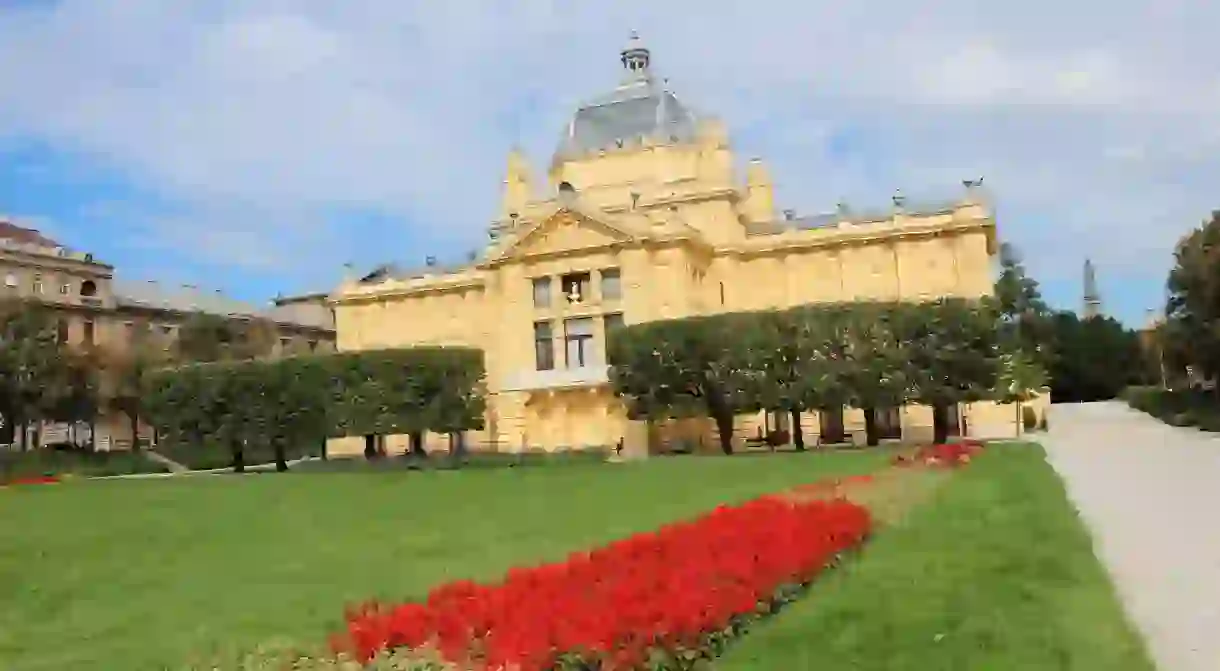12 Things Culture Vultures Should Do in Zagreb

First-time visitors to Zagreb realise pretty quickly that the city is big on art – it’s all around. Street art, such as the murals alongside the train station, is everywhere. Further unconventional works sit in the Museum of Contemporary Art and several cutting-edge galleries, and Old Masters hang in traditional museums such as the Mimara and Strossmayer Gallery.
MUU
Building, Museum, Train Station

MUU is the acronym for Muzej ulične umjetnosti, ‘Museum of Street Art’. This is not a museum in the sense of a building and opening hours, rather a random but striking collection of murals around the streets of Zagreb. Generally used to brighten former industrial buildings and sites, MUU is most notably seen on the long wall that runs parallel to the rails from the train station, a street known as Branimirova.
Croatian Museum of Naïve Art
Museum
Set in the Raffay Palace surrounded by the prestigious buildings of the Upper Town, the Croatian Museum of Naïve Art holds nearly 2,000 examples of works by self-taught artists, mainly from the 1930s to the 1970s. Many lived and worked in and around Zagreb, or at the village of Hlebine close to the Hungarian border were a style developed depicting the every day realities of rural life. There are usually some 80 pieces on display at any one time.
Museum of Contemporary Art
Museum, Cinema

In a suitably radical building designed by Igor Franić, its twists and turns illustrating the architect’s love of the shape of the river meanders, the Museum of Contemporary Art is the most significant cultural opening in the Croatian capital for several generations. Replacing its predecessor that was located in the Upper Town, the MCA (or MSU in Croatian) re-energises Novi Zagreb, an area of Socialist-era housing. Holding some 10,000-plus artifacts from the mid 20th century onwards, including pioneering pieces of computer art, the MSU regularly stages temporary exhibitions worthy of investigation.
Lauba
Bistro
This gallery, bistro and cultural centre opened in 2011, a marriage of commerce and culture. The Lauba is the presentation space for the collection of Croatian contemporary works collated by the Filip Trade distribution company, pro-active in the local arts scene. Displayed on a rotating basis, it continually features new artists supported by the organisation. The Lauba also provides free daily tours upon arrangement.
Art Pavilion
Building, Train Station

Facing Zagreb’s train station, the Art Pavilion looks like any other grandiose Habsburg palace of culture. It was originally built of iron, conceived for the Millennial Exhibition of 1896 that took place in Budapest then transported back here, where it was made into a permanent construction by architects Fellner and Helmer. Today it provides an airy and atmospheric space for significant temporary exhibitions that come to town, including one featuring Giacometti in 2017.
Mimara Museum
Museum

The most comprehensive collection of prominent art in Croatia, let alone Zagreb, the Mimara was founded by the private collector of the same name, who obtained many of the works while operating as a cultural consultant during World War II. When he died in 1987, he left his Manets, Turners and Canalettos to the nation, which duly converted this stately school building into a museum. It’s an embarrassment of riches and one that requires at least half a day to go round.
Galerija Nova

Right in the heart of Zagreb, the Galerija Nova stages constantly challenging exhibitions, talks and performances, at a small venue close to the city’s main square. It is run by a collective of four local artists, whom operate the venue according to the concept of WHW (‘What, How and for Whom?’), adopting an analytical approach to its ever-changing agenda.
Atelijer Meštrović
More than 300 works by Rodin contemporary Ivan Meštrović are housed here in his former Atelijer, now a museum. The prolific Meštrović himself restored these interlinked 17th-century properties, which are the showcases for his pieces in stone, marble, bronze and wood, some on display his former studio by an ivy-covered courtyard.
Galerija Miroslav Kraljević
The Galerija Miroslav Kraljević or GMK for short, was set up by artists, curators and critics in 1986 as an independent, non-profit space. Named after the influential painter and sculptor who died at 27 on the eve of World War I, the GMK provides a platform and gallery space to contemporary artists whose work calls into question modern-day society.
Strossmayer Gallery of Old Masters
Building, Park
Endearingly old-school, the Strossmayer Gallery of Old Masters is the home for the 256 paintings that were collected by the influential bishop of the same name. Bequeathing his private collection to the nation, he has allowed generations of art lovers to appreciate the lesser-known works of the Italian Renaissance, as well as pieces by El Greco and Jean-Antoine Gros.
Meštrovićev paviljon
Mosque, Museum

While holding no permanent collection, the Meštrovićev paviljon plays an important role in the cultural life of the city. Seat of the Croatian Associations of Artists, it stages regular exhibitions and art events, following through on its original purpose when designed by famed Croatian sculptor Ivan Meštrović on the eve of World War II. The conflict then changed its function – and sent Meštrović into exile – but after serving as a mosque and then a war museum, the building is once more in the hands of those it was intended for: artists.
Modern Gallery
The Modern Gallery is home to some 10,000 works by domestic artists from the 1800s to the present day, housed in the Vranyczany Palace built in the 1880s. Along with the 750 or so on rotating display, paintings, sculptures, installations and even pieces of video art, the Moderna also now features the Tactile Gallery MG, the first multi-sensory gallery in the region for visually impaired people.













